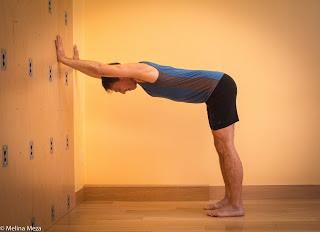 And a pose where you lift your leg toward your body or bend your torso toward your legs, such as Standing Forward Bend or Reclined Leg Stretch, will stretch the backs of your legs.
And a pose where you lift your leg toward your body or bend your torso toward your legs, such as Standing Forward Bend or Reclined Leg Stretch, will stretch the backs of your legs.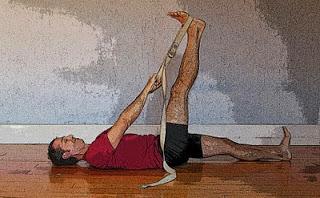 The second way is by moving and out of a pose that stretches the muscles the muscles you want to release, going into the pose with an inhalation and releasing with an exhalation. This is called a mini vinyasa or a dynamic pose. For example, you practice Arms Overhead pose by raising your arms overhead on an inhale and lowering them on an exhale. Repeating this movement several times can release tension from your shoulder muscles.
The second way is by moving and out of a pose that stretches the muscles the muscles you want to release, going into the pose with an inhalation and releasing with an exhalation. This is called a mini vinyasa or a dynamic pose. For example, you practice Arms Overhead pose by raising your arms overhead on an inhale and lowering them on an exhale. Repeating this movement several times can release tension from your shoulder muscles.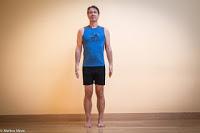
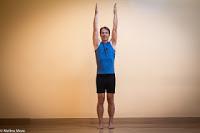
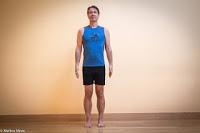 Likewise, moving in and out of Standing Forward Bend with your breath can release tension from the backs of your legs. If you practice this way, try to move slowly and gently, because moving (and breathing) too fast can overstimulate you and may cause your muscles to tense up rather than relax.Depending on what you’re comfortable with or enjoy the most, you can practice in either one of these styles or even combine the two. I typically practice static poses in the Iyengar style, not vinyasas, but I do often include the Cat-Cow and Bridge pose vinyasas in my sequences.In both types of poses, be careful to keep your stretches gentle, backing off if you feel any pain (a mild stretchy sensation is fine). For static stretches, I suggest holding the stretch at least for 20 seconds because that’s the minimum amount of time needed to trigger relaxation in a muscle. (If you want to improve your flexibility over time, try holding your poses for at least 90 seconds.) For dynamic stretches, I suggest 6 to 8 repetitions.When you practice a sequence of poses, I suggest you end your practice with a relaxing pose, such as Savasana, because relaxing physically can also help release physical tension and this will counteract the stimulating effects of the active poses.Choosing PosesIn every single yoga pose except Mountain pose and Savasana, you are stretching some muscles while contracting some others. For example, if you step your feet wide apart for a standing pose, you’re stretching your inner legs and contracting your outer legs. If you take your arms behind you, you’re stretching the fronts of your shoulders while contracting the backs of them. And in twists, you’re stretching one side of your body while contracting the other. So, a balanced asana practice—with a mix of standing poses, forward bends, backbends, twists, and inverted poses—will provide an all-over release for your body.But if you want to target a certain area of your body, look for poses that stretch the areas that you want to release by studying the shapes of poses and/or feeling what stretches while you’re practicing them. If you want a quieter stretch, choose seated or reclined poses. For more active stretching (or if you are in a place where you need stand up), choose standing poses. If choosing by yourself feels intimidating, try my suggestions below or ask your teacher for some recommendations. You can also look for articles or books that address how to “stretch” a certain area of your body, such as your hips, your back, your shoulders, and so on, and articles about “office yoga” or “travel yoga” have good tips for stretches you can do out in public.But because everyone is different—some people are naturally flexible, others are naturally less flexible, and others are naturally flexible in some parts of their bodies but not in others—you’ll have to try the poses to see what works best for you. For example, some flexible people love seated forward bends for releasing their leg muscles but if you’re not particularly flexible in the backs of your legs, you may dislike these poses. So, maybe for you, a better choice would be Reclined Leg Stretch, which might feel more comfortable for your back. Likewise, some flexible people may love Downward Dog for releasing their shoulder muscles but those who are less flexible in the shoulders may struggle with this pose. So, maybe for you, a better choice would be a pose where you have your arms are overhead but you don’t bear weight on them.Sometimes other body type variations or even personal preferences can affect which poses you should choose. For example, some people find twists helpful for back tension while others may prefer forward bends. So, pay attention to your body as you try different poses. If you enjoy a pose and feel a gentle stretch in the area where you want to release tension, go for it. But if you feel uncomfortable in a pose—or just dislike it—try another pose instead.For some stretching sequences, see Featured Sequence: Upper Body Flexibility, Featured Sequence: Lower Body Flexibility, and 7 Poses for a Yoga Break. For a long list of single poses you could do during a yoga break, see Rethinking Office Yoga.Subscribe to Yoga for Healthy Aging by Email ° Follow Yoga for Healthy Aging on Facebook ° To order Yoga for Healthy Aging: A Guide to Lifelong Well-Being, go to Amazon, Shambhala, Indie Bound or your local bookstore.
Likewise, moving in and out of Standing Forward Bend with your breath can release tension from the backs of your legs. If you practice this way, try to move slowly and gently, because moving (and breathing) too fast can overstimulate you and may cause your muscles to tense up rather than relax.Depending on what you’re comfortable with or enjoy the most, you can practice in either one of these styles or even combine the two. I typically practice static poses in the Iyengar style, not vinyasas, but I do often include the Cat-Cow and Bridge pose vinyasas in my sequences.In both types of poses, be careful to keep your stretches gentle, backing off if you feel any pain (a mild stretchy sensation is fine). For static stretches, I suggest holding the stretch at least for 20 seconds because that’s the minimum amount of time needed to trigger relaxation in a muscle. (If you want to improve your flexibility over time, try holding your poses for at least 90 seconds.) For dynamic stretches, I suggest 6 to 8 repetitions.When you practice a sequence of poses, I suggest you end your practice with a relaxing pose, such as Savasana, because relaxing physically can also help release physical tension and this will counteract the stimulating effects of the active poses.Choosing PosesIn every single yoga pose except Mountain pose and Savasana, you are stretching some muscles while contracting some others. For example, if you step your feet wide apart for a standing pose, you’re stretching your inner legs and contracting your outer legs. If you take your arms behind you, you’re stretching the fronts of your shoulders while contracting the backs of them. And in twists, you’re stretching one side of your body while contracting the other. So, a balanced asana practice—with a mix of standing poses, forward bends, backbends, twists, and inverted poses—will provide an all-over release for your body.But if you want to target a certain area of your body, look for poses that stretch the areas that you want to release by studying the shapes of poses and/or feeling what stretches while you’re practicing them. If you want a quieter stretch, choose seated or reclined poses. For more active stretching (or if you are in a place where you need stand up), choose standing poses. If choosing by yourself feels intimidating, try my suggestions below or ask your teacher for some recommendations. You can also look for articles or books that address how to “stretch” a certain area of your body, such as your hips, your back, your shoulders, and so on, and articles about “office yoga” or “travel yoga” have good tips for stretches you can do out in public.But because everyone is different—some people are naturally flexible, others are naturally less flexible, and others are naturally flexible in some parts of their bodies but not in others—you’ll have to try the poses to see what works best for you. For example, some flexible people love seated forward bends for releasing their leg muscles but if you’re not particularly flexible in the backs of your legs, you may dislike these poses. So, maybe for you, a better choice would be Reclined Leg Stretch, which might feel more comfortable for your back. Likewise, some flexible people may love Downward Dog for releasing their shoulder muscles but those who are less flexible in the shoulders may struggle with this pose. So, maybe for you, a better choice would be a pose where you have your arms are overhead but you don’t bear weight on them.Sometimes other body type variations or even personal preferences can affect which poses you should choose. For example, some people find twists helpful for back tension while others may prefer forward bends. So, pay attention to your body as you try different poses. If you enjoy a pose and feel a gentle stretch in the area where you want to release tension, go for it. But if you feel uncomfortable in a pose—or just dislike it—try another pose instead.For some stretching sequences, see Featured Sequence: Upper Body Flexibility, Featured Sequence: Lower Body Flexibility, and 7 Poses for a Yoga Break. For a long list of single poses you could do during a yoga break, see Rethinking Office Yoga.Subscribe to Yoga for Healthy Aging by Email ° Follow Yoga for Healthy Aging on Facebook ° To order Yoga for Healthy Aging: A Guide to Lifelong Well-Being, go to Amazon, Shambhala, Indie Bound or your local bookstore.

